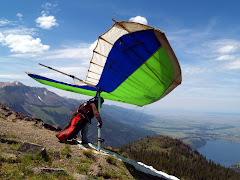 This weekend was devoted to repairing the training glider, a Delta Wing Dream 185, that was damaged on the training hill by a paraglider pilot last fall. While showboating, the pilot lost control of his wing and smashed into the nose as Ken and I were preparing a student for a flight down the hill. No one was hurt, but both leading edges and several battens were damaged. After several hours, some creative repairwork, and a good quantity of aluminum tubing, we managed to make the repairs necessary to get the old bird (built in 1989 - she'll be 20 on the first day of spring) back in ship-shape. Many students, including Ken, first left the ground beneath this big wing, so it was a nostalgic moment when we made a few test runs down Ken's driveway and she appeared to trim out nicely.
This weekend was devoted to repairing the training glider, a Delta Wing Dream 185, that was damaged on the training hill by a paraglider pilot last fall. While showboating, the pilot lost control of his wing and smashed into the nose as Ken and I were preparing a student for a flight down the hill. No one was hurt, but both leading edges and several battens were damaged. After several hours, some creative repairwork, and a good quantity of aluminum tubing, we managed to make the repairs necessary to get the old bird (built in 1989 - she'll be 20 on the first day of spring) back in ship-shape. Many students, including Ken, first left the ground beneath this big wing, so it was a nostalgic moment when we made a few test runs down Ken's driveway and she appeared to trim out nicely.



We also took the opportunity to assemble and inspect an even older bird that I had recently acquired. As far as we've been able to determine, this one is an Eipper-Formance Flexi-2 18. I have a book published in 1977 that shows the specs on this wing, so it's at least 30 years old. The amazing thing about it is that it shows very little wear as though it had hardly if ever been flown. Ken and I have decided that it'll look good suspended from the ceiling of our hang gliding shop (if we ever start one, that is). It might just be a good trainer for a smaller student as well, and we may take it out to the training hill and give it a try ourselves.
In any case, we're ready to get back to training, weather permitting of course...




